Equipment used to produce Vagabonding.com
What equipment did I use to produce Vagabonding.com? What about software? How did I carry everything? What about security? Why am I always wearing a blue shirt and grey pants?
Read on, curious traveler.
Take note that I wrote this nine months into the trip; the kit is about as streamlined and refined as it's going to get.
> Hardware
Fujitsu P2000 Lifebook laptop computer – I researched laptop computers endlessly for this trip, and this little Fujitsu was the best machine for my purposes. It was a netbook before they made netbooks. Just 3.5 lbs (1.6 kg) in size, it burned discs and had a Firewire port (used to transfer video between camera and computer). I composed all Vagabonding content on this computer, enjoyed a huge music library, archived materials to disc, and even watched the occasional DVD. Of course, if I were doing it all over again, I'd bring a MacBook. But at the time they were too clunky.
|
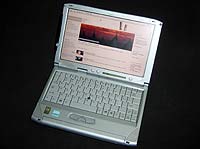 |
Panasonic AG-DVX100 Mini-DV Camera – this was the showpiece of my kit. At 4 lbs (1.8 kg), this was the smallest professional DV camera on the market. And it was a durable workhorse. I used it in rainforests, deserts, and at freezing high-altitudes; in every condition, it performed like a champ. I brought this camera because Panasonic gave it to me. Yep, I wrote them and asked for sponsorship right as this guy was coming out and they sent it to me for free. Gotta love Panasonic. However, if I were doing it again, I'd bring the smallest damn camera I could that still had a microphone jack. Seriously. I wasn't making a documentary film. I was shooting video for the web. A little Flip HD camera would have been fine. And it would have looked a lot less conspicuous! Ah well. |
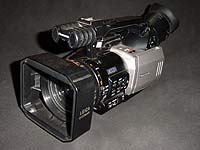 |
Shure SM11 wired
lavaliere microphone – I bought Shure's least expensive
lavaliere microphone when I was in Kolkata, India – four months into
the trip. I wished I'd had it from the start. I clipped it onto interviewees
and, even in noisy surroundings, their audio sounds dynamic and clean. I
also use this microphone for my voiceovers. All the audio I captured before
having this microphone is junk. |
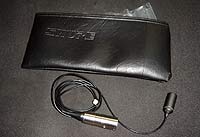 |
Manfrotto 3001D tripod – what good is a big honking camera without an equally big tripod? At 3 lbs (1.35 kg), this is Manfrotto's lightest tripod, and I fitted it with one of their lightest fluid heads, the 3130. This tripod and head performed remarkably well, especially considering the number of times I dropped them, bashed em around, bounced them off bike racks, etc. Out in the field, I carried the tripod in a quiver-like bag that
I had made in Vietnam for $3. When moving from place to place, I stowed it in my main backpack. |
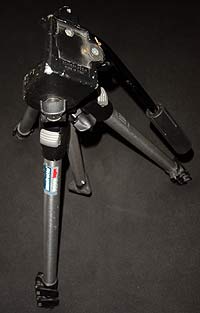 |
Sony digital camera – I don't care what anybody says – as far as consumer digital cameras go, nobody comes close to Sony. This is the second Sony digital camera I've owned, and I love it. It was tiny but powerful. It also does mini-movies with sound, a feature that I use for the underwater videos. I carry two extra batteries for the camera and an extra Memory
Stick. |
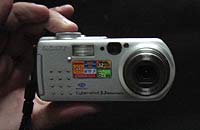 |
Sony
Marine Pack – this ingenious plastic housing is custom-made
for the P5. Good for up to 40m below the surface, I've used this housing
to take photos and
videos
while diving. Sony makes the marine packs for other camera models too, although
I hear they're discontinuing them. |
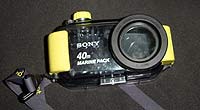 |
Fujitsu
USB Floppy drive – Old school, yes. But when I was traveling many PCs didn't have USB ports, and I traveled just before wireless was ubiquitous in cafes and so on. I used the floppy to transfer data from the laptop to the
Internet cafes. |
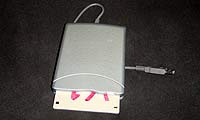 |
IOGear mini optical
mouse – the little nubbin on laptop computers was fine
for quick bouts of navigation, but when you're editing photos or working
on video, you need a proper mouse. This little guy did the trick. |
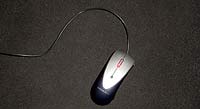 |
> Cables and Power cords
I carried the standard power adaptors and connector cables for my equipment. I also had two sets of headphones. The one noteworthy item from this group is a global plug adaptor called the Road Warrior. It was the most compact plug adaptor I've seen, and the design is elegant. I'm not sure who makes it, but if you dig around on Google you'll find it. I also used a small Belkin surge protector called the Master Cube. |
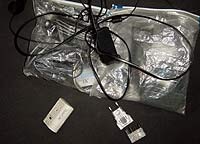 |
> Security and Protection
The number one rule of my security setup was, whenever I was on the move – be it by bus, train, plane, or rickshaw – I carried the laptop and cameras with me and never let them go.
Crumpler
Messenger bag – The laptop and camera fit perfectly
into a padded messenger bag made by Crumpler. With pouches and pockets
that held all of my gear well, this bag seemed custom-engineered for
my project. Its styling was discreet and rugged, and even at the end of the trip it looked great. |
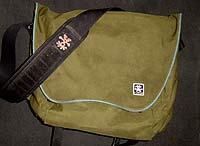 |
PacSafe
– another key security item was the PacSafe - a wire-mesh
sack that you can lock your stuff inside of and then secure to a piece of furniture or something. Whenever I wasn't using the DV camera or
computer they were secured inside of this baby. Sure, a determined crook
could easily hack through this contraption, but it goes a long way
in preventing opportunistic theft. |
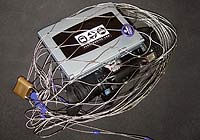 |
Sea
to Summit Bags – to keep the electronics dry when I
lugged them about, I stored them in three Sea to Summit dry bags. They rock. |
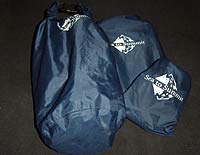 |
Insuarance with Safeware - the laptop and cameras were insured with Safeware, which is really the best form of security and protection. It's wasn't easy finding this sort of coverage. After many rejections by traditional insurance companies, I found Safeware. |
> Software
MoveableType personal publishing system – MoveableType is the content management engine that drives Vagabonding.com, although I modified it a great deal. The MT system automated the publishing and archiving process.
Gallery – the Vagabonding photo galleries run on a tool called Gallery that automated the posting process. It did the job during the trip but these days I'd just post them to Flickr.
Adobe Premiere 6.5 – I used Premiere to capture digital video, edit the movies you see on this site, and export them as medium-resolution files. Nowadays I use Final Cut Express and believe it is vastly superior.
Cleaner 5 – I used Cleaner to crunch video files down to Web-friendly sizes. It worked well for Windows Media videos, but was spotty with QuickTime exports.
Adobe Photoshop 7.0 – I used Photoshop to tweak and resize photos and export them for the Web.
Dreamweaver MX – I used Dreamweaver as a visual HTML editor to develop the travelogue article pages and other Web layouts (such as this page).
Soundforge 5.0 – I occasionally used Soundforge to edit audio files for the Vagabonding videos.
> Clothing
I balanced out my big electronics rig with a minimalist clothing kit:
- 3 collared shirts
- 1 pair pants
- 1 swimsuit/shorts
- two pair socks
- two pair underwear
- one packable rain jacket
- one pair shower sandals
- one pair hiking shoes
- one pair sport sandals
I washed clothes in hotel room sinks every few days. And I wore the same stuff over and over and over. Which didn't bother me too much – I was never in one place long enough for anyone to notice.
The noteworthy items from this group were my Chaco sandals. Never have I had a more comfortable – or smoove – pair of sandals. I wore those babies for 270 days in a row and they still looked smart. Also, Chacos served as a sort of ID card for North Americans, as anybody who had them was from the US or Canada. |
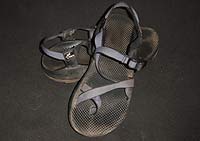 |
> Miscellaneous
Sticky mat – I used this for doing yoga in hotel rooms (physical exercise is one of the keys to maintaining a positive frame of mind on the road). I clipped the mat to the outside of my backpack when I was on the move and hoped no one would kick my ass for being a yoga fairy.
Dreamsack - I carried a silk sleep sack but seldom needed to use it.
Medical kit – bandages, malaria meds, etc.
Suture/syringe kit – thankfully I never had to use it.
Panasonic Mini DV tapes - at any given time I had about 20 of these in my pack.
DVDs – I carried a bunch of bootleg DVDs that I'd purchased in Asia.
Blank CD-Rs - I carreid a spindle of 30.
PackTowel – from the makers of Thermarest, this little towel dried fast.
Mini chess board – just in case a worthy opponent turned up.
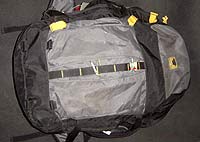 >
Backpack
>
Backpack
All clothing and miscellany, along with the tripod, went into a 55-liter backpack made by MountainSmith. It was a rugged companion. It zipped open like a suitcase for easy access, and the straps zipped into a compartment so as not to get caught on airport carousels.
In total, I carried 55 lbs (25 kilos).

